
The Acropolis of Athens is an ancient citadel located on a rocky outcrop above the city of Athens, Greece, and contains the remains of several ancient buildings of great architectural and historical significance, the most famous being the Parthenon. The word Acropolis is from the Greek words ἄκρον and πόλις. The term acropolis is generic and there are many other acropoleis in Greece. During ancient times the Acropolis of Athens was also more properly known as Cecropia, after the legendary serpent-man Cecrops, the supposed first Athenian king.
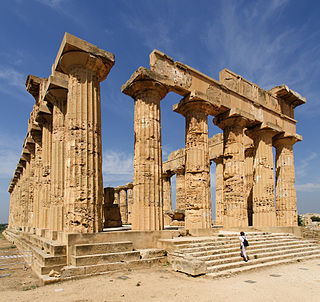
Selinunte was a rich and extensive ancient Greek city of Magna Graecia on the south-western coast of Sicily in Italy. It was situated between the valleys of the Cottone and Modione rivers. It now lies in the comune of Castelvetrano, between the frazioni of Triscina di Selinunte in the west and Marinella di Selinunte in the east.
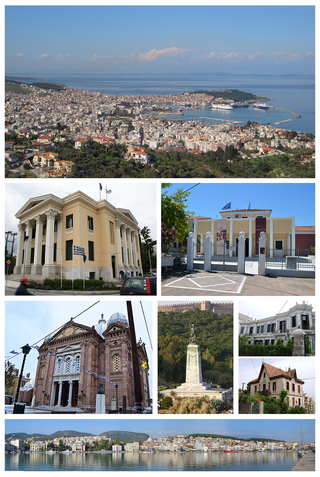
Mytilene is the capital of the Greek island of Lesbos, and its port. It is also the capital and administrative center of the North Aegean Region, and hosts the headquarters of the University of the Aegean. It was founded in the 11th century BC.

Lindos is an archaeological site, a fishing village and a former municipality on the island of Rhodes, in the Dodecanese, Greece. Since the 2011 local government reform it is part of the municipality Rhodes, of which it is a municipal unit. The municipal unit has an area of 178.9 km2. It lies on the east coast of the island. It is about 40 km south of the city of Rhodes and its fine beaches make it a popular tourist and holiday destination. Lindos is situated in a large bay and faces the fishing village and small resort of Charaki.

Monemvasia is a town and municipality in Laconia, Greece. The town is located in mainland Greece on a tied island off the east coast of the Peloponnese, surrounded by the Myrtoan Sea. Monemvasia is connected to the rest of the mainland by a tombolo 400 metres (1,300 ft) in length.
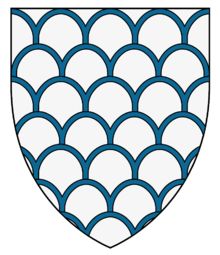
The House of Gattilusio was a powerful Genoese family who controlled a number of possessions in the northern Aegean from 1355 until the mid 15th century. Anthony Luttrell has pointed out that this family had developed close connections to the Byzantine ruling house of the Palaiologos—"four successive generations of Gattilusio married into the Palaiologos family, two to emperors' daughters, one to an emperor, and one to a despot who later became an emperor"—which could explain their repeated involvement in Byzantine affairs. The Gattilusi were Lords of Lesbos from 1355 to 1462 and Lords of Aenus from 1376 to 1456.

Assos was an ancient Greek city near today's Behramkale or Behram for short, which most people still call by its ancient name of Assos. It is located on the Aegean coast in the Ayvacık district of Çanakkale province, Turkey. It is on the southern side of Biga Peninsula. Assos sits on the coast of the Adramyttian Gulf and used to offer the only good harbour along the 80 kilometres (50 mi) of coast which made it very important for shipping in the Troad.

Lesbos or Lesvos is a Greek island located in the northeastern Aegean Sea. It has an area of 1,633 km2 (631 sq mi), with approximately 400 kilometres of coastline, making it the third largest island in Greece and the eighth largest in the Mediterranean. It is separated from Asia Minor by the narrow Mytilini Strait. On the southeastern coast is the island's capital and largest city, Mytilene (Μυτιλήνη), whose name is also used for the island as a whole. Lesbos is a separate regional unit with the seat in Mytilene, which is also the capital of the larger North Aegean region. The region includes the islands of Lesbos, Chios, Ikaria, Lemnos, and Samos. The total population of the island was 83,068 in 2021. A third of Lesbians live in the capital, while the remainder are concentrated in small towns and villages. The largest are Plomari, Kalloni, the Gera Villages, Agiassos, Eresos, and Molyvos.
Phigalia or Phigaleia or Phigalea, also known as Phialia, was an ancient Greek city in the south-west corner of ancient Arcadia, in the region of ancient Parrhasia close to the frontiers of Messenia, and upon the right bank of the Neda, about halfway between the sources and the mouth of this river. It is also the present name of a nearby modern village, known up to the early 20th century as Pavlitsa (Παύλιτσα). In modern geography it is located in southeastern Elis. It is situated on an elevated rocky site, among some of the highest mountains in the Peloponnese, the most conspicuous being Mt Cotylium and Mt Elaeum; the identification of the latter is uncertain.

Enez is a town in Edirne Province, in East Thrace, Turkey. The ancient name of the town was Ainos, Latinised as Aenus. It is the seat of Enez District. Its population is 4,301 (2022). The mayor is Özkan Günenç (CHP).

Kalloni is a town in the west-central part of the island of Lesbos, Greece. It is the seat of the West Lesbos municipality and the Kalloni municipal unit within it. Prior to 2011 the current municipal unit was a municipality. The name also existed in ancient times, though the conventional transcription of the classical name in English is "Callone".

Francesco II Gattilusio was the second Gattilusio lord of Lesbos, from 1384 to his death. He was the third son of Francesco I Gattilusio and Maria Palaiologina, the sister of the Byzantine emperor John V Palaiologos.
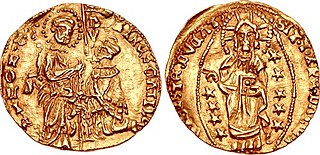
Dorino Gattilusio was the fourth Gattilusio Lord of Lesbos from 1428 until his death. He ruled Lesbos at a time of increasing Ottoman power, and his last years were preoccupied with maintaining some measure of independence.
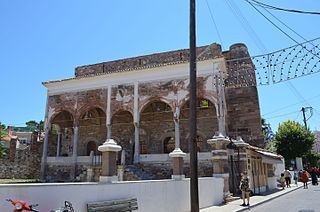
The Yeni Mosque is a historical Ottoman mosque in Mytilene on the island of Lesbos in Greece.
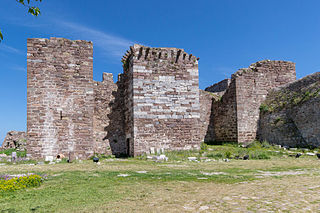
The Ottoman conquest of Lesbos took place in September 1462. The Ottoman Empire, under Sultan Mehmed II, laid siege to the island's capital, Mytilene. After its surrender, the other forts of the island surrendered as well. The event put an end to the semi-independent Genoese lordship that the Gattilusio family had established in the northeastern Aegean since the mid-14th century, and heralded the beginning of the First Ottoman–Venetian War in the following year.
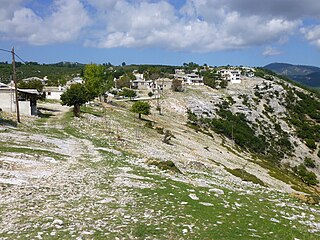
Kastro is a small village in the interior of the Greek island of Thassos. It is believed to be the oldest village on the island. The village name comes from the old castle that existed here to protect the inhabitants. The village is located in the centre of the island, at a height of 450–500 m above sea level. It can be reached from Limenaria on an asphalt road or from Theologos on a dirt road.
The Temple of Demeter Amphictyonis was an extra-urban sanctuary in ancient Anthele in Thermopylae, dedicated to Demeter. It was an important Panhellenic shrine of Demeter and one of her main cult centers in Greece. It was also known as a center of the Amphictyonic League.
The Sanctuary of Demeter and Kore was a sanctuary in ancient Syracuse in Sicily, Magna Graecia, dedicated to Demeter and Kore (Persephone).
The Intraurban Sanctuary of Demeter and Persephone was an intraurban sanctuary in ancient Cyrene in Libya, dedicated to Demeter and Persephone.

The Valide Mosque is a historical mosque in Mytilene, on the island of Lesbos in Greece.

























